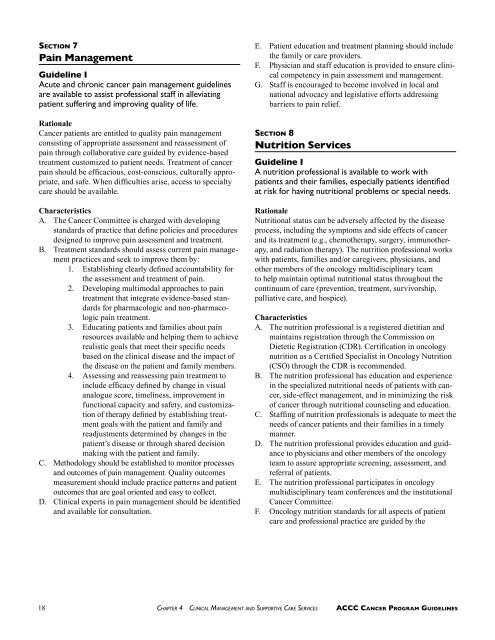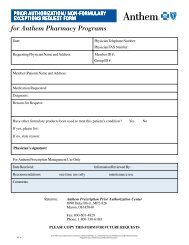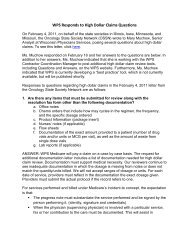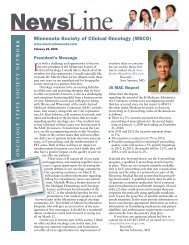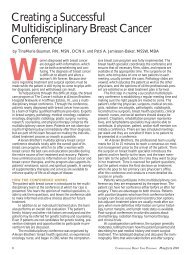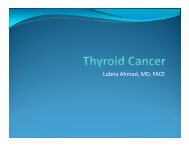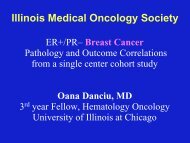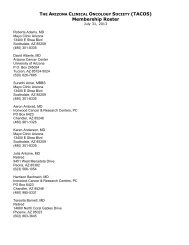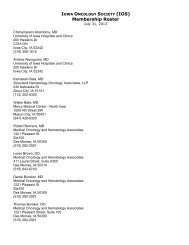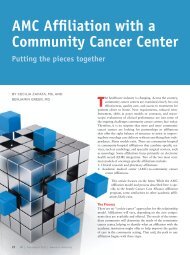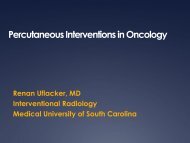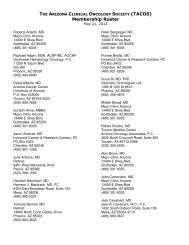Cancer Program Guidelines - Association of Community Cancer ...
Cancer Program Guidelines - Association of Community Cancer ...
Cancer Program Guidelines - Association of Community Cancer ...
You also want an ePaper? Increase the reach of your titles
YUMPU automatically turns print PDFs into web optimized ePapers that Google loves.
Section 7<br />
Pain Management<br />
Guideline I<br />
Acute and chronic cancer pain management guidelines<br />
are available to assist pr<strong>of</strong>essional staff in alleviating<br />
patient suffering and improving quality <strong>of</strong> life.<br />
Rationale<br />
<strong>Cancer</strong> patients are entitled to quality pain management<br />
consisting <strong>of</strong> appropriate assessment and reassessment <strong>of</strong><br />
pain through collaborative care guided by evidence-based<br />
treatment customized to patient needs. Treatment <strong>of</strong> cancer<br />
pain should be efficacious, cost-conscious, culturally appropriate,<br />
and safe. When difficulties arise, access to specialty<br />
care should be available.<br />
Characteristics<br />
A. The <strong>Cancer</strong> Committee is charged with developing<br />
standards <strong>of</strong> practice that define policies and procedures<br />
designed to improve pain assessment and treatment.<br />
B. Treatment standards should assess current pain management<br />
practices and seek to improve them by:<br />
1. Establishing clearly defined accountability for<br />
the assessment and treatment <strong>of</strong> pain.<br />
2. Developing multimodal approaches to pain<br />
treatment that integrate evidence-based standards<br />
for pharmacologic and non-pharmacologic<br />
pain treatment.<br />
3. Educating patients and families about pain<br />
resources available and helping them to achieve<br />
realistic goals that meet their specific needs<br />
based on the clinical disease and the impact <strong>of</strong><br />
the disease on the patient and family members.<br />
4. Assessing and reassessing pain treatment to<br />
include efficacy defined by change in visual<br />
analogue score, timeliness, improvement in<br />
functional capacity and safety, and customization<br />
<strong>of</strong> therapy defined by establishing treatment<br />
goals with the patient and family and<br />
readjustments determined by changes in the<br />
patient’s disease or through shared decision<br />
making with the patient and family.<br />
C. Methodology should be established to monitor processes<br />
and outcomes <strong>of</strong> pain management. Quality outcomes<br />
measurement should include practice patterns and patient<br />
outcomes that are goal oriented and easy to collect.<br />
D. Clinical experts in pain management should be identified<br />
and available for consultation.<br />
E. Patient education and treatment planning should include<br />
the family or care providers.<br />
F. Physician and staff education is provided to ensure clinical<br />
competency in pain assessment and management.<br />
G. Staff is encouraged to become involved in local and<br />
national advocacy and legislative efforts addressing<br />
barriers to pain relief.<br />
Section 8<br />
Nutrition Services<br />
Guideline I<br />
A nutrition pr<strong>of</strong>essional is available to work with<br />
patients and their families, especially patients identified<br />
at risk for having nutritional problems or special needs.<br />
Rationale<br />
Nutritional status can be adversely affected by the disease<br />
process, including the symptoms and side effects <strong>of</strong> cancer<br />
and its treatment (e.g., chemotherapy, surgery, immunotherapy,<br />
and radiation therapy). The nutrition pr<strong>of</strong>essional works<br />
with patients, families and/or caregivers, physicians, and<br />
other members <strong>of</strong> the oncology multidisciplinary team<br />
to help maintain optimal nutritional status throughout the<br />
continuum <strong>of</strong> care (prevention, treatment, survivorship,<br />
palliative care, and hospice).<br />
Characteristics<br />
A. The nutrition pr<strong>of</strong>essional is a registered dietitian and<br />
maintains registration through the Commission on<br />
Dietetic Registration (CDR). Certification in oncology<br />
nutrition as a Certified Specialist in Oncology Nutrition<br />
(CSO) through the CDR is recommended.<br />
B. The nutrition pr<strong>of</strong>essional has education and experience<br />
in the specialized nutritional needs <strong>of</strong> patients with cancer,<br />
side-effect management, and in minimizing the risk<br />
<strong>of</strong> cancer through nutritional counseling and education.<br />
C. Staffing <strong>of</strong> nutrition pr<strong>of</strong>essionals is adequate to meet the<br />
needs <strong>of</strong> cancer patients and their families in a timely<br />
manner.<br />
D. The nutrition pr<strong>of</strong>essional provides education and guidance<br />
to physicians and other members <strong>of</strong> the oncology<br />
team to assure appropriate screening, assessment, and<br />
referral <strong>of</strong> patients.<br />
E. The nutrition pr<strong>of</strong>essional participates in oncology<br />
multidisciplinary team conferences and the institutional<br />
<strong>Cancer</strong> Committee.<br />
F. Oncology nutrition standards for all aspects <strong>of</strong> patient<br />
care and pr<strong>of</strong>essional practice are guided by the<br />
18 Chapter 4 Clinical Management and Supportive Care Services ACCC <strong>Cancer</strong> <strong>Program</strong> <strong>Guidelines</strong>


